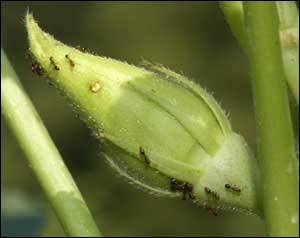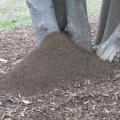Control Fire Ants in and Around Home Vegetable Gardens
Fire ants are common pests in home vegetable gardens. They directly damage some vegetables, especially okra and Irish potatoes, but they also damage gardeners! Gardeners who unknowingly step in mounds while working in the garden can be stung dozens, or even hundreds, of times. Fire ants foraging on peas and other vegetables to tend aphids or collect plant exudates will sting gardeners who are picking the fruit.
Fire ants are the most common pests of home lawns in Mississippi. They are not welcome guests! Unknowingly stepping in a fire ant mound can ruin an otherwise pleasant time in the yard.
The best way to keep fire ants out of your vegetable garden is to do a good job of controlling them in your lawn, especially the area immediately outside the garden. Granular baits work well for this purpose, but keep in mind that most of the fire ant baits used in home lawns are not approved for use directly in vegetable gardens. This is not a particular problem because most of the fire ants that invade small to medium sized gardens come from mounds located in the lawn area around the outside of the garden. Apply a labeled fire ant bait to a 50 to 75 foot wide band around the outside of the garden two to three times per year in spring, mid-summer, and fall, and you will have a lot fewer problems with fire ants in the garden. Just remember, baits are slow-acting and have to be used preventively. See Extension Publication 2429, Control Fire Ants in Your Yard for more details.
There are usually fewer fire ant mounds in tilled areas, such as gardens and fields, because tilling disturbs the ants and causes them to move. But there will be some mounds that persist, despite being disturbed by tillage.
Some fire ant baits can be used in the garden and lawn. These include baits containing the active ingredients methoprene (Extinguish is an example) or spinosad (Greenlight Fire Ant Bait with Conserve, and Safer Fire Ant Bait are examples, and both these products are even approved for organic production). Baits containing spinosad are relatively fast-acting and this makes them a good choice for controlling mounds that occur in the garden itself, but it will still take a two or three weeks to see results. Don’t wait until you have big mounds, go ahead and apply one of these baits as soon as you see fire ants moving into the garden. But don’t forget to treat the lawn area around the outside of the garden as well. Workers from mounds located just outside the garden will readily forage into the garden area.
Liquid Mound Drenches for Use in the Garden: You can use a liquid drench to eliminate large mounds that need to be controlled quickly, but be sure to use an insecticide labeled for use in home vegetable gardens. Many insecticides commonly used in home vegetables include label directions for mixing and applying as a mound drench. Products containing the active ingredients spinosad, permethrin, or carbaryl are quite effective as mound drenches and are often used to control other pests in the home vegetable garden. See Extension Publication 2347, Insect Pests of the Home Vegetable Garden for recommendations on control of other garden insects.
Use a watering can, or similar container, to mix and apply the drench. Just read the label, mix the specified amount of insecticide in water, and pour over the mound. The key to success with liquid drenches is to use enough liquid to thoroughly soak the mound. Depending on the size of the mound, this ranges from one to two gallons. Begin by applying about ¼ of the total volume to a 10 to 12 inch band around the outside of the mound. This prevents the queen from escaping through underground foraging tunnels and improves control of workers. Then apply the rest of the drench directly to the mound. Liquid drenches are time consuming to mix and apply, but when applied properly they will eliminate a mound within a few hours.
Caution: Do not use mound treatments containing the active ingredient acephate in the vegetable garden (Ortho Fire Ant Killer is one example). Acephate is commonly used to treat fire ant mounds in home lawns, but it must not be used around edible plants. Acephate is a systemic insecticide that is readily absorbed by plant roots and translocated to leaves and fruit of vegetables.
More Information
Extension Publication 2429, Control Fire Ants in Your Yard
Extension Publication 2347, Insect Pests of the Home Vegetable Garden
Fire Ant Biology
Contact information for Dr. Blake Layton.
Publications
News
Sunshine and long days make summertime in the South desirable for people, but those same conditions are exactly what allows the dreaded, imported fire ants to thrive.
Almost any sunny, grassy area left unattended will soon be home to fire ants. Fire ants were accidentally imported from South America to Mobile in the 1930s and have since spread throughout the Southeast.
Everyone loves a good myth buster, and we have a very timely one for you! Fire ant beds in your yard can be such a headache to deal with. Many people have used home remedies to control ants. But are those quick fixes really getting rid of the ants in your yard? Let’s take a look at some commonly used home remedies and whether or not they work!
Do you have fire ants in your vegetable garden? Me too. Good news for all of us! There are some fire ant baits that are safe to use around food plants.



